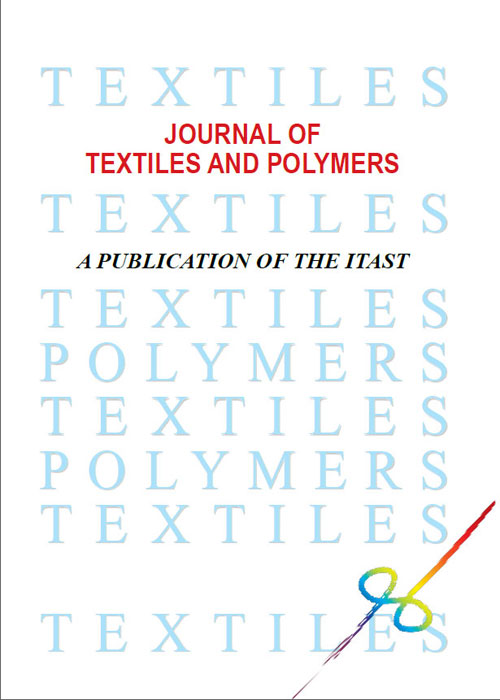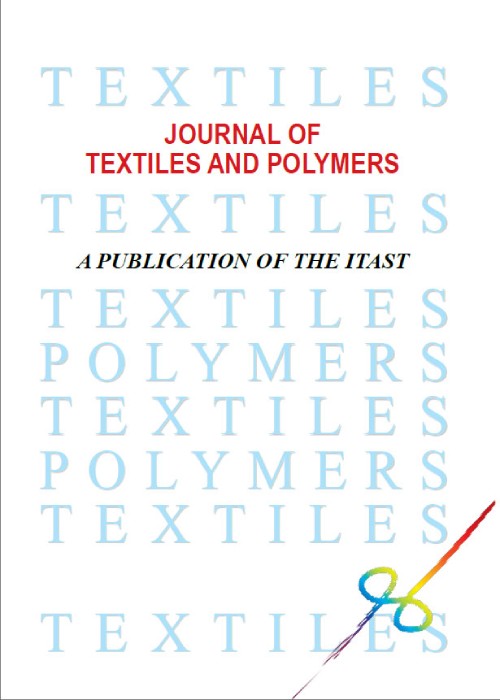فهرست مطالب

Journal of Textiles and Polymers
Volume:6 Issue: 2, Spring 2018
- تاریخ انتشار: 1397/07/05
- تعداد عناوین: 7
-
-
Pages 59-66Basalt fiber offers an economic alternative to carbon fiber for the manufacture of composite parts. In this research, homogenous and intra-ply hybrid composites of basalt and nylon fibers have been produced in order to investigate the effects of bending speed and fiber volume ratio on the bending damage of composite structure. Five different types of woven fabric as reinforcement and different volume percentages of nylon including 0, 25, 33.33, 50 and 100% were used. All composites consisted of six-ply laminates were prepared using hand lay-up method. Three-point bending test was used in this research. The residual tensile strength values was employed in order to study the amount of bending damage of samples. The results demonstrated the highest residual tensile strength for the samples containing 33.33, 50 and 100% nylon fiber. Also, with increasing bending speed, the influence of the content of nylon and basalt on the residual tensile strength became more and more important.Keywords: residual tensile strength, bending damage, intra-ply hybrid, basalt, nylon
-
Pages 67-75In the present work, recycled polyethylene terephthalate (R-PET), virgin fiber grade PET (FG-PET) and bottle grade PET (BG-PET) chips were spun on a high spinning speed machine into filament yarns and the influence of high-speed spinning process at the speeds of 3000 and 3500 m/min and the spinning temperatures of 280, 285 and 290 °C on the fiber properties was studied. The increase in the take-up speed increased the density, optical birefringence, crystal size, amorphous and crystal orientation, tenacity and initial modulus of recycled-PET and bottle grade filament. The study on the intrinsic viscosity (IV) showed that the recycling process resulted in decreasing the molecular weight of polymers and narrowing the molecular weight distributions. At higher spinning temperatures, the crystallinity, crystal size, tensile and intrinsic viscosity values decreased but the shrinkage increased. In this part of the study, it was found that the R-PET can be a good candidate for using in high-speed melt spinning processes, and the filaments with proper confidants were received from the recycled-PET.Keywords: filament, temperature, PET, recycling, melt spinning
-
Pages 77-82The theme of this research paper is to create a cost comparison report between yarn made from the expensive China Hui Hong polyester fiber and yarn made by blending ring spun of polyester of less costly Khalis Fiber Limited (KFL) and Pakistan Synthetic Limited (PSL). Polyesters yarns of 30Ne were made on ring spinning frame at different recipes of KFL and PSL, i.e., 100% KFL, 75% KFL+25% PSL, 60% KFL+40% PSL, 50% KFL+50% PSL, 40% KFL+60% PSL, and 100% PSL and then the costs for all fibers compared with those for 100% China optical Hui Hong fiber. Yarn cost and production effecting parameters were determined such as yarn ounces per spindle (OPS), yarn yield and monthly profit. Based on the results, comparison reports were made using Uster Tester 4. The theme of this report is to establish a methodology to achieve more margin with demanding market trends, customer requirement, and product application for yarn spinning industry.Keywords: OPS, Yield%, spindle cost, conversion cost
-
Transport Characteristics of Benzene through Palm Mesocarp Fibre/Low Density Polyethylene CompositesPages 83-95The transport characteristics of benzene through palm mesocarp fibre (PMF)-reinforced low density polyethylene (LDPE) composites have been studied in the temperature range 40–80 °C. The diffusion behavior of benzene through these composite samples was studied, with special reference to the effect of filler content, filler particle size, and temperature. Transport coefficients including diffusion, permeation, and sorption coefficients were estimated. The effect of alkali treatment on the solvent uptake and swelling parameters was also analyzed. All the composites showed a decrease in the uptake of solvent, but the effect was more in the case of alkali-treated composites. The solvent uptake decreased more so with particle size decreasing. The transport mechanism of diffusion was found to be close to Fickian and may be regarded as “less Fickian”. The van’t Hoff’s relationship was used to determine the thermodynamic parameters. The energy of activation and transport kinetics of the composites have been evaluated.Keywords: palm mesocarp fiber, benzene, transport coefficients, swelling parameters, alkali treatment, transport kinetics
-
Pages 97-105Smart hydrogels have the ability to respond to various kinds of stimulus such as physical stimuli including temperature, electric fields, solvent composition, light, pressure, sound and magnetic fields, and chemical or biochemical stimuli including pH, ions, glucose, enzyme, antigen and DNA. Smart hydrogels are an interesting class of materials that can be prepared by variety methods. The molecular design of polymer architectures of smart hydrogels is particularly important to show the potentially powerful combination of thermodynamic and kinetic regulation of smart hydrogels. The objective of this series is to present the latest research results together with basic concepts from the viewpoints of their preparation methods and classification (Part I) and characterizations and applications (Part II). Future trends in this area of research are presented and issues regarding technology development and new applications are highlighted.Keywords: smart hydrogels, stimuli, stimuli-responsive hydrogels, biomaterial, drug delivery
-
Pages 107-115The aim of this study is to present a method to predict the geometrical parameters of relaxed fabrics using energy method. For this purpose, the potential energy of on-loom state of fabric is calculated and minimized to achieve theoretically the fully relaxed state. Tensile, bending and compression deformations of yarns are considered to obtain total strain energy of the unit-cell. Peirce’s geometric model for woven fabrics is used in order to find geometrical equations. The predictions are compared with experimental data and the results are discussed.Keywords: relaxed state, woven fabric, geometry, energy method
-
Pages 117-120The overarching objective is to investigate the status of Ethiopian Textile Industry. Primary data were collected through observation, personal and telephone interviews. Besides, secondary data were compiled from company documents and research institutes. The data were analyzed using simple statistical tools and inductive and deductive reasoning. The major findings are: the cultivated land is 3.7% with a productivity of 19.8 ql/ha; the combined ginning capacity is 1,031 ton/day; the daily performance of spinning mills is 386.4 ton and the capacity of composite and knitting mills is 578,576 meters per day of fabric. The trend indicates that there is a negative trade balance. Despite these facts, there is a large area of land suitable for cotton cultivation, tremendous trainable labor force and a conducive policy for the expansion of textile industry.Keywords: cultivated, productivity, ginning, trade, labor


